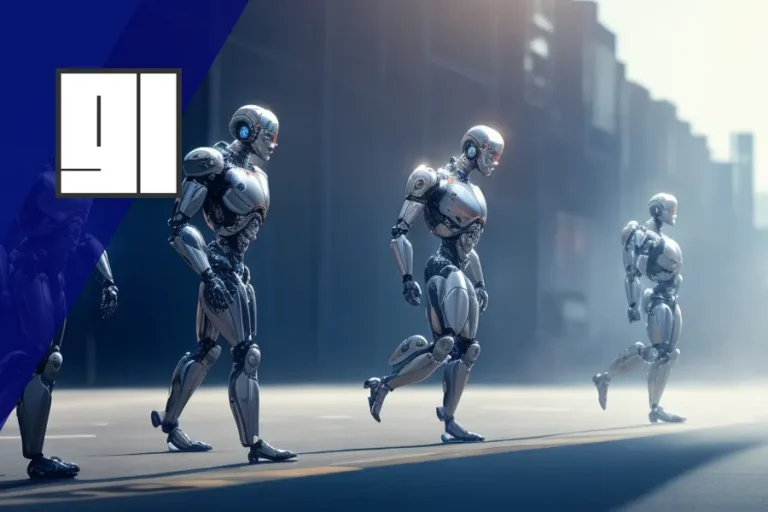The Evolution of Artificial Intelligence
In today’s fast-paced world, the rise of Artificial Intelligence (AI) is revolutionizing various aspects of human life. AI has become a vital part of our everyday routines, from smartphones to self-driving cars. But have you ever wondered how this unstoppable force came into existence? Join us on a journey through time as we explore the fascinating evolution of Artificial Intelligence.
Understanding Artificial Intelligence
Before we take a close look into the history of AI, let’s take a moment to understand what Artificial Intelligence entails. In simple terms, AI refers to the development of computer systems that can perform tasks that would typically require human intelligence.
From problem-solving to speech recognition, AI aims to replicate human-like cognitive abilities, enabling computers to learn, reason, and make decisions autonomously.
Definition of Artificial Intelligence
Artificial Intelligence is the field of computer science that focuses on creating intelligent machines capable of performing tasks that would typically require human intelligence.
These machines are designed to analyze complex data, adapt to new situations, and interact with their environment in a way that mimics human thought processes.
The Basic Principles of AI
At its core, AI is built upon three fundamental principles:
- Learning
- Reasoning
- Perception
Learning involves gathering and analyzing data, recognizing patterns, and adapting behavior accordingly. Reasoning refers to making logical deductions and decisions based on available information. Lastly, Perception entails understanding and interpreting sensory input, such as speech or images.
Regarding learning, AI systems employ various techniques to acquire knowledge and improve their performance. One of the most common methods is machine learning algorithms, which enable computers to learn from large datasets and make predictions or decisions based on patterns they identify.
Reasoning, on the other hand, allows AI systems to make logical deductions and draw conclusions based on the information they have. This involves the application of rules and algorithms to process data and arrive at a solution or decision. Reasoning can be deductive, where conclusions are drawn from general principles, or inductive, where general principles are inferred from specific observations.
Perception plays a crucial role in AI systems, enabling them to understand and interpret sensory input. This includes speech recognition, image processing, and natural language understanding. By analyzing and interpreting sensory data, AI systems can extract meaningful information and use it to make informed decisions or take appropriate actions.
Furthermore, AI systems can be categorized into Narrow AI and General AI. Narrow AI, also known as weak AI, is designed to perform specific tasks and is limited to the domain it was trained in. For example, a voice assistant like Siri or Alexa is a narrow AI programmed to understand and respond to specific voice commands.
On the other hand, General AI, also known as strong AI, aims to possess the same intelligence and cognitive abilities as a human being. General AI would be capable of understanding and performing any intellectual task that a human can do. However, the development of General AI is still a topic of ongoing research and remains a challenge for AI.
In conclusion, Artificial Intelligence is an exciting field that aims to develop intelligent machines capable of performing tasks that typically require human intelligence. By leveraging learning, reasoning, and perception, AI systems can analyze data, make decisions, and interact with their environment in a way that mimics human thought processes. As the field continues to advance, the possibilities for AI applications are vast, ranging from autonomous vehicles to healthcare and beyond.
The Early Days of Artificial Intelligence
The birth of AI can be traced back to a momentous event in history – the creation of the Turing Test by British mathematician and computer scientist Alan Turing. Developed in 1950, the Turing Test assessed a machine’s ability to exhibit intelligent behavior indistinguishable from a human’s.
Alan Turing proposed that if a machine could successfully pass for a human in a conversation, it could be considered artificially intelligent. This groundbreaking concept laid the foundation for further exploration and development of AI technologies.
The Birth of AI: The Turing Test
Alan Turing’s idea of the Turing Test revolutionized the field of artificial intelligence. It posed a fundamental question: Can machines think? This question sparked a wave of excitement and curiosity among scientists and researchers worldwide.
The Turing Test became a benchmark for evaluating the progress of AI. It challenged scientists to create machines that could convincingly imitate human intelligence. This led to a flurry of research and experimentation as experts sought to unlock the secrets of creating intelligent machines.
AI in the 1950s and 1960s: The First AI Programs
In the following decades, the field of AI witnessed significant advancements. The first AI programs were created, and researchers began exploring various approaches to artificial intelligence. From symbolic logic to problem-solving algorithms, scientists delved deeper into the realm of machine intelligence.
One notable achievement during this era was the creation of the Logic Theorist by Allen Newell and Herbert A. Simon in 1956. This program became the first computer program capable of proving mathematical theorems.
The Logic Theorist was a groundbreaking development in the field of AI. It demonstrated that machines could perform tasks, reason, and solve complex problems. This achievement opened up new possibilities for the future of AI, inspiring researchers to push the boundaries of what machines could do.
During the 1960s, AI research expanded further, with scientists exploring different approaches to machine learning. This era saw the development of early neural networks and the exploration of expert systems, which aimed to capture human expertise in specific domains.
As the field of AI grew, so did the excitement and optimism surrounding its potential. Researchers believed that AI had the power to revolutionize various industries and solve complex problems that had long perplexed humanity.
However, despite the progress made during this period, AI was still in its infancy. The capabilities of machines were limited, and there were many challenges to overcome. But the early days of AI laid the groundwork for future breakthroughs and set the stage for future advancements.
The AI Winter: Challenges and Setbacks
Despite the early milestones in AI, the field experienced a series of setbacks in the 1970s and 1980s, often referred to as the AI Winter. Funding cuts and pessimism shrouded the progress of AI, slowing down its development.
During the AI Winter, the field of artificial intelligence faced numerous challenges that impacted its growth and potential. One of the major obstacles was the significant reduction in funding for AI research. The lack of financial support hindered the exploration of new ideas and the execution of ambitious projects. As a result, many promising initiatives were left unfinished, and the momentum building in the field came to a screeching halt.
Moreover, the prevailing pessimism surrounding AI during this period cannot be underestimated. The initial enthusiasm and optimism that had characterized the early years of AI research were replaced by skepticism and doubt. The unmet expectations and limited practical applications of AI led to a widespread belief that the field had reached its limits. The lofty goals set by early researchers were now seen as unachievable, further dampening the spirits of those involved in AI.
Funding Cuts and Pessimism
Due to unmet expectations and limited practical applications, funding for AI research dwindled. Many believed that AI had reached its limits and that the lofty goals set by early researchers were unachievable.
The funding cuts had far-reaching consequences for the AI community. Research institutions struggled to secure resources, and talented scientists and engineers were forced to abandon their AI projects or seek opportunities in other fields. The lack of financial support hindered the progress of ongoing research and discouraged new talent from entering the field. The AI Winter casts a long shadow over the future of artificial intelligence.
This period of discouragement and skepticism significantly hindered progress in AI, impeding further breakthroughs. The once vibrant and dynamic AI community now grappled with uncertainty and stagnation. The AI Winter was a challenging time for everyone involved as they grappled with the question of whether AI would ever live up to its potential.
The Impact of the AI Winter on Development
Despite the challenges faced during the AI Winter, it became a valuable learning experience for researchers. It highlighted the need to focus on practical applications and develop AI technologies that could provide tangible benefits to society.
Researchers shifted their focus towards developing AI systems that could solve real-world problems and deliver practical value. This shift in perspective was crucial in revitalizing the field and restoring confidence in its potential. The AI Winter forced the AI community to reevaluate their approach and adopt a more pragmatic mindset.
While progress may have slowed during this time, it paved the way for a resurgence of AI that would shape the future of technology. The lessons learned from the AI Winter laid the foundation for the subsequent advancements in the field. Researchers started to explore new avenues, leveraging the power of machine learning and data-driven approaches to push the boundaries of AI further than ever before.
Today, AI is integral to our lives, from voice assistants and recommendation systems to autonomous vehicles and medical diagnosis. Though challenging, the setbacks faced during the AI Winter ultimately served as a catalyst for innovation and paved the way for the AI revolution we are experiencing today.
The Resurgence of AI: Machine Learning and Big Data
With the dawn of the digital age came a renewed interest in AI. The emergence of machine learning and the availability of vast amounts of data propelled AI into a new era of innovation.
The Rise of Machine Learning
Machine learning, a subfield of AI, focuses on developing algorithms that enable computers to learn and make predictions or decisions without being explicitly programmed.
By leveraging statistical techniques and pattern recognition, machine learning algorithms can analyze massive datasets, identify trends, and make informed predictions, making them valuable tools across various industries.
The Role of Big Data in AI Development
One of the driving forces behind the resurgence of AI is the abundant availability of big data. As the digital landscape continues to expand, immense volumes of data are generated every second.
This wealth of information fuels AI algorithms, allowing them to gain insights and enhance performance. Big data is the fuel that powers the AI engine, enabling machines to become even more intelligent and efficient.
Modern AI: Deep Learning and Neural Networks
The latest advancements in AI technology have led to the emergence of deep learning and neural networks. These cutting-edge approaches have revolutionized the field, opening up exciting possibilities for the future.
Understanding Deep Learning
Deep learning is a subset of machine learning that focuses on training artificial neural networks. Neural networks are composed of layers of interconnected nodes, known as neurons, that simulate the behavior of neurons in the human brain.
By stacking multiple layers, deep learning algorithms can learn complex data representations, allowing them to solve various problems, including image and speech recognition, natural language processing, and more.
The Power of Neural Networks
Neural networks have proven remarkably powerful in tackling complex tasks that were once considered out of reach for computers. Their ability to learn from vast amounts of data and extract meaningful insights has propelled AI into new frontiers.
From self-driving cars to virtual assistants, neural networks are transforming industries and redefining what is possible with AI. The exponential growth of computing power and data availability continues to fuel advancements in this field, promising a future where machines can perform even more advanced tasks.
In Conclusion
The evolution of Artificial Intelligence is a testament to humanity’s relentless pursuit of innovation. From the early days of the Turing Test to the modern era of deep learning and neural networks, AI has come a long way.
As technology continues to advance, the possibilities for AI are endless. With each milestone achieved, we come closer to creating machines with true human-like intelligence, revolutionizing how we live, work, and interact with the world.

Graz is a tech enthusiast with over 15 years of experience in the software industry, specializing in AI and software. With roles ranging from Coder to Product Manager, Graz has honed his skills in making complex concepts easy to understand. Graz shares his insights on AI trends and software reviews through his blog and social media.







